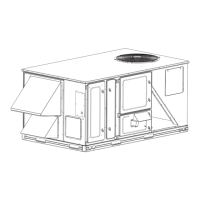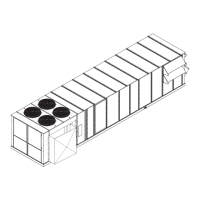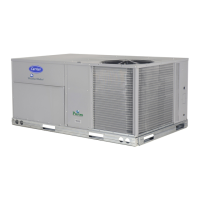What does Alert Code T415 mean on my Carrier 48/50PD05 Air Conditioner?
- MMichael GarzaSep 23, 2025
Alert Code T415 indicates a bad sensor, bad wiring, or a sensor configured incorrectly. Check sensor and wiring.

What does Alert Code T415 mean on my Carrier 48/50PD05 Air Conditioner?
Alert Code T415 indicates a bad sensor, bad wiring, or a sensor configured incorrectly. Check sensor and wiring.
What to do if my Carrier 48/50PD05 Air Conditioner shows Communication Failure?
If the Scrolling Marquee or Navigator display shows a Communication Failure, or the green or yellow LEDs do not flash on the boards, use an ohm meter to measure the resistance on the communication pins of the boards to determine if a board is faulty. If the reading is less than half the value indicated in Table 7, then the board needs to be replaced.
Why is the red LED on my Carrier 48/50PD05 Air Conditioner blinking?
The red LED on the ECB and AUX1 indicates different states. If the red LED is not blinking, check the DIP switch positions on the board. If the red LEDs are not blinking in unison, verify that correct power is being supplied to all modules. A blinking red LED at the rate of once per second means that software is not loaded on the board. A board LED that is lit continuously indicates that the board should be replaced.
What does Alert Code T133 mean on my Carrier 48/50PD05?
Alert Code T133 indicates a low refrigerant charge, dirty filters, the evaporator fan operating backwards, a loose or broken belt, a plugged filter drier, a faulty transducer, excessively cold return air, or a stuck open economizer when the ambient temperature is low. This alert resets automatically.
What does Alert Code T126 mean on my Carrier Air Conditioner?
Alert Code T126 indicates an overcharged system, high outdoor ambient temperature coupled with a dirty outdoor coil, a plugged filter drier, or a faulty high–pressure switch. This alert resets automatically.
What does Alert Code T064 mean on my Carrier 48/50PD05 Air Conditioner?
Alert Code T064 is caused by a faulty thermistor, a shorted or open thermistor caused by a wiring error, or a loose connection. Use OAT to control Outdoor fans.
What does Alarm Code A404 mean on my Carrier 48/50PD05?
Alarm Code A404 indicates that an auxiliary device is trying to shut down the unit, such as a smoke detector. Verify that the configuration is set correctly, and verify the wiring and auxiliary device.
What to do for Alert Code T066 on Carrier 48/50PD05 Air Conditioner?
Reload factory defaults or reinstall software on the MBB. Consult the network manager if alert continues.
What does Alert Code T414 mean on my Carrier Air Conditioner?
Alert Code T414 indicates that the economizer actuator is out of calibration. Initiate economizer calibration (Service Test?INDP? E.CAL) using the Service Test menu.
What does Alert Code T110 mean on my Carrier 48/50PD05?
Alert Code T110 indicates low refrigerant pressure or a faulty suction pressure. Use the Scrolling Marquee to reset the alert.
| Energy Efficiency Ratio (EER) | 11.0 |
|---|---|
| Refrigerant | R-410A |
| Phase | 1 |
| Type | Air Conditioner |
| Cooling Capacity | 5 Ton |
| Stages | Single Stage |
| Power Supply | AC |
| Voltage | 208/230V |
Details specific hazards including electrical shock, unit damage, fire, and explosion risks associated with HVAC operation.
Provides general information on the unit, ComfortLink control system, Scrolling Marquee, and Navigator display.
Explains unit operation, System Pilot devices, and Carrier Comfort Network (CCN) interface for system management.
Covers essential pre-start-up steps including unit preparation, component checks, electrical connections, and filter installation.
Guides users through initial control configuration, setting up application specifics, and programming operating schedules.
Details various operating modes, display settings, unit configurations, setpoints, inputs, outputs, and CCN settings.
Explains sequences for economizer, IAQ, power exhaust, cooling, heating, free cooling, and ventilation modes.
Provides detailed instructions for configuring the unit for the Carrier Comfort Network (CCN).
Covers general troubleshooting, alarm handling, unit stoppage conditions, and restart procedures.
Provides specific troubleshooting guidance for components like DSC, economizer, fans, gas heat, VFD, and sensors.
Presents tables for diagnosing cooling, gas heating, and economizer issues based on problem and cause.
Details the main control boards (MBB, ECB, AUX1, DSC, IGC) and their wiring schematics and connections.
Explains Variable Frequency Drive (VFD) operation, terminal strip connections, and various field-installed accessories.
Covers VFD modes, keypad operation, parameter settings, backup, and upload/download procedures.
Details VFD fault codes, alarm codes, diagnostic procedures, and recommended maintenance intervals.
Provides detailed fan performance data (RPM, BHP) for various models under different static pressure conditions.
Details how to log unit settings and configurations for various modes like DISP, UNIT, COOL, HEAT, ECON, ALM, PID.
Provides a comprehensive checklist for unit pre-start-up checks and initial start-up electrical, temperature, and pressure readings.












